Stop redirects to/from message-alert.center
Notification SpamAlso Known As: message-alert.center pop-up
Get free scan and check if your device is infected.
Remove it nowTo use full-featured product, you have to purchase a license for Combo Cleaner. Seven days free trial available. Combo Cleaner is owned and operated by RCS LT, the parent company of PCRisk.com.
What is message-alert[.]center?
Like thousands of others (e.g. bigclicker.me, dredrewlaha.info, checking-your-browser.com and etc.), message-alert[.]center is a rogue website. Designed to cause rampant redirects to compromised and possibly malicious sites, as well as delivery of highly dubious content.
What should be known, is that few users ever enter it willingly. Most get redirected from other similarly harmful sites (specifically, by clicking on intrusive advertisements therein), or by having it forcefully opened by PUAs (potentially unwanted applications).
It must be emphasized that express user consent is unnecessary for these apps to invade their devices. PUAs generate redirects, deliver invasive ad campaigns and some can even track data.
![message-alert[.]center pop-up redirects](/images/stories/screenshots201906/message-alertcenter-homepage.jpg)
Rogue sites (message-alert[.]center included) proliferate through redirects caused by intrusive adverts and unwanted applications. The actions of these sites are determined by visitor's geolocation, which they infer by checking user's IP (Internet Protocol) address.
Once this data is known, the sites either redirect visitors to other unreliable/malicious websites and/or begin feeding them questionable content. What is also pertinent to know about message-alert[.]center, is its misuse of browser notifications.
By hiding the consent options underneath clickbait ("click here to verify that you are 18 or older", "press Allow to access newest/viral articles/news/videos/movies/etc.", "click here to verify, that you are not a robot" and many other examples), this website can trick users into permitting its notifications.
If consented to, message-alert[.]center starts running invasive advert campaigns. These ads are considered a threat, due to the untrustworthy/malignant websites they redirect to and their ability to execute scripts, designed to make autonomous downloads/installs of PUAs.
As previously mentioned, said apps also generate redirects and can deliver advertisement campaigns (pop-ups, coupons, banners and etc.).
Through the enablement of third party graphical content, done by employing a variety of tools, the ads they deliver can seriously affect browser performance and consequently diminish the browsing experience (i.e. they can slow down browsing speed and overlay site content).
Another ability that some undesirable applications have is data tracking. By monitoring browsing activity (mainly, search engine and browsing histories), they can gather personal information (IP address, geolocation and real-life user identity details). This data is then passed onto third parties (potentially, cyber criminals), seeking to misemploy it for financial gain.
Therefore PUAs can cause serious browser and system invasions/infections, as well as severe privacy issues (even lead to identity theft). To ensure device and user safety, all rogue applications must be eliminated immediately.
| Name | message-alert.center pop-up |
| Threat Type | Push notifications ads, Unwanted ads, Pop-up ads |
| Serving IP Address | 213.227.145.147 |
| Observed Domains | 776c2.message-alert[.]center, cjvx7.message-alert[.]center, df7u5.message-alert[.]center, fr62s.message-alert[.]center, jxthe.message-alert[.]center, mu45h.message-alert[.]center, wxbwv.message-alert[.]center |
| Symptoms | Seeing advertisements not originating from the sites you are browsing. Intrusive pop-up ads. Decreased Internet browsing speed. |
| Distribution Methods | Deceptive pop-up ads, potentially unwanted applications (adware) |
| Damage | Decreased computer performance, browser tracking - privacy issues, possible additional malware infections. |
| Malware Removal (Windows) |
To eliminate possible malware infections, scan your computer with legitimate antivirus software. Our security researchers recommend using Combo Cleaner. Download Combo CleanerTo use full-featured product, you have to purchase a license for Combo Cleaner. 7 days free trial available. Combo Cleaner is owned and operated by RCS LT, the parent company of PCRisk.com. |
Typically, PUAs appear highly legitimate and completely harmless. They tricks users into installing them by advertising a variety of "useful" features.
Although, the abilities they boast seem very beneficial and practical - they are rarely functional. It must be understood, that the only purpose that unwanted apps serve is to generate revenue for their developers; to users they are practically useless. Rogue applications generate redirects, run intrusive advertisement campaigns and gather sensitive data.
How did adware install on my computer?
Most PUA invasions occur through install pack/bundles. "Bundling" is a deceitful marketing method, by which regular software is packed together with rogue apps. While opt-outs are often possible, they are frequently hidden behind "Custom/Advanced" settings.
As hasty and inexperience users have a tendency to use pre-set install settings, skip steps and ignore terms - they can easily fall prey to PUAs infiltrating their computers. Another mode of undesired app spreading is through rogue installs done by invasive adverts.
How to avoid installation of potentially unwanted applications?
It is strongly advised to always use official and verified sources for downloading software. As opposed to untrustworthy sources: P2P (peer-to-peer) sharing networks and other third party downloaders, as they are more likely to have bundled programs.
Users are encouraged to study installation terms and possible options, to ensure that they are installing exactly what they intend to and there is no foul play involved. Using "Custom/Advanced" install settings and opting-out/declining from installing/downloading additional applications/features is highly recommended.
Exercising care, avoiding suspicious sites and ads - are among prudent browsing advices. As intrusive advertisements are designed to appear legitimate and absolutely ordinary, falling prey to them becomes quite easy. However, a telltale sign of an invasive advert can be the websites it redirects to (e.g. gambling, pornography, adult-dating and similar).
Should users encounter such ads/redirects, they are recommended to inspect their device and remove all dubious applications and/or browser extensions/plug-ins. If your computer is already infected with rogue applications, we recommend running a scan with Combo Cleaner Antivirus for Windows to automatically eliminate them.
Appearance of message-alert[.]center website (GIF):
![message-alert[.]center website appearance (GIF)](/images/stories/screenshots201906/message-alertcenter-appearance.gif)
Instant automatic malware removal:
Manual threat removal might be a lengthy and complicated process that requires advanced IT skills. Combo Cleaner is a professional automatic malware removal tool that is recommended to get rid of malware. Download it by clicking the button below:
DOWNLOAD Combo CleanerBy downloading any software listed on this website you agree to our Privacy Policy and Terms of Use. To use full-featured product, you have to purchase a license for Combo Cleaner. 7 days free trial available. Combo Cleaner is owned and operated by RCS LT, the parent company of PCRisk.com.
Quick menu:
- What is message-alert.center pop-up?
- STEP 1. Remove spam notifications from Google Chrome
- STEP 2. Remove spam notifications from Google Chrome (Android)
- STEP 3. Remove spam notifications from Mozilla Firefox
- STEP 4. Remove spam notifications from Microsoft Edge
- STEP 5. Remove spam notifications from Safari (macOS)
Disable unwanted browser notifications:
Video showing how to disable web browser notifications:
 Remove spam notifications from Google Chrome:
Remove spam notifications from Google Chrome:
Click the Menu button (three dots) on the right upper corner of the screen and select "Settings". In the opened window select "Privacy and security", then click on "Site Settings" and choose "Notifications".
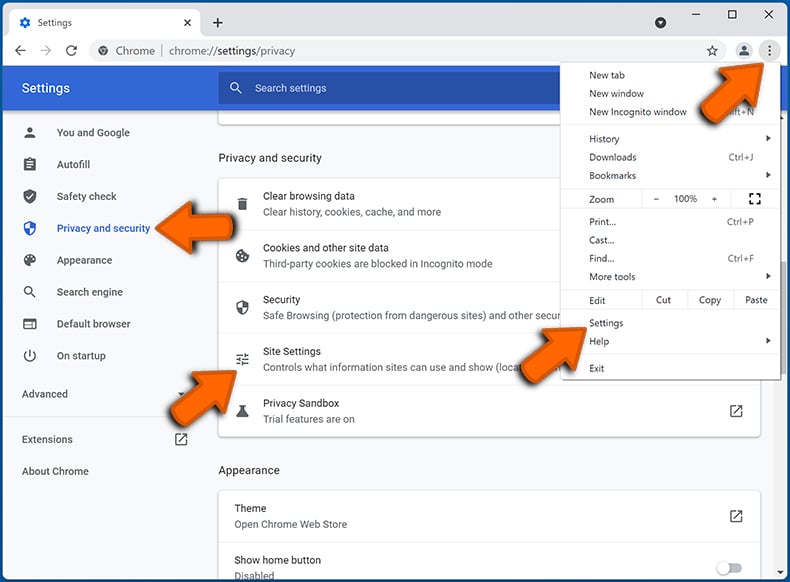
In the "Allowed to send notifications" list search for websites that you want to stop receiving notifications from. Click on the three dots icon near the website URL and click "Block" or "Remove" (if you click "Remove" and visit the malicious site once more, it will ask to enable notifications again).
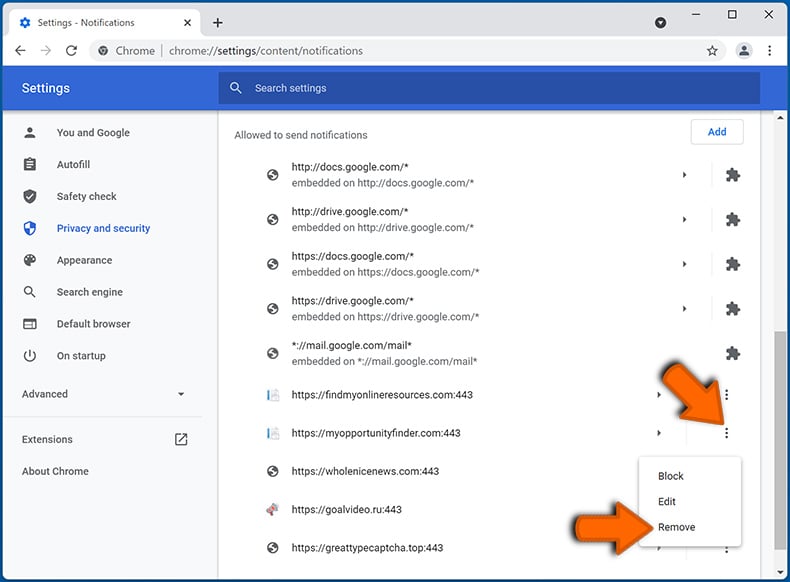
 Remove spam notifications from Google Chrome (Android):
Remove spam notifications from Google Chrome (Android):
Tap the Menu button (three dots) on the right upper corner of the screen and select "Settings". Scroll down, tap on "Site settings" and then "Notifications".
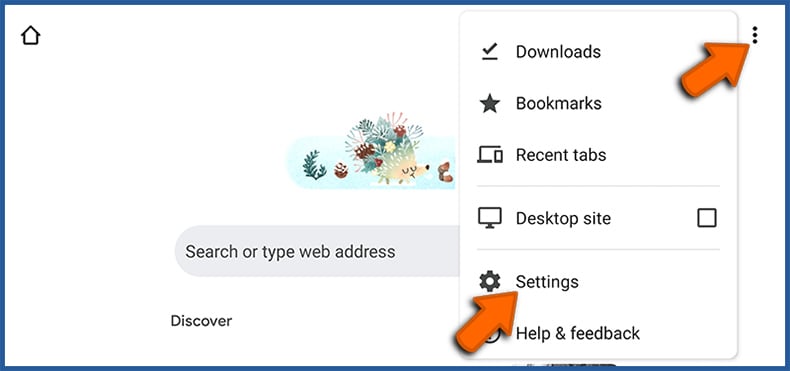
In the opened window, locate all suspicious URLs and tap on them one-by-one. Once the pop-up shows up, select either "Block" or "Remove" (if you tap "Remove" and visit the malicious site once more, it will ask to enable notifications again).
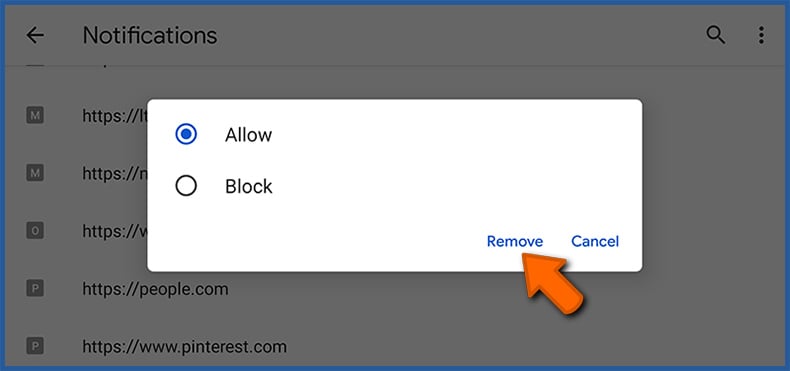
 Remove spam notifications from Mozilla Firefox:
Remove spam notifications from Mozilla Firefox:
Click the Menu button (three bars) on the right upper corner of the screen. Select "Settings" and click on "Privacy & Security" in the toolbar on the left hand side of the screen. Scroll down to the "Permissions" section and click the "Settings" button next to "Notifications".
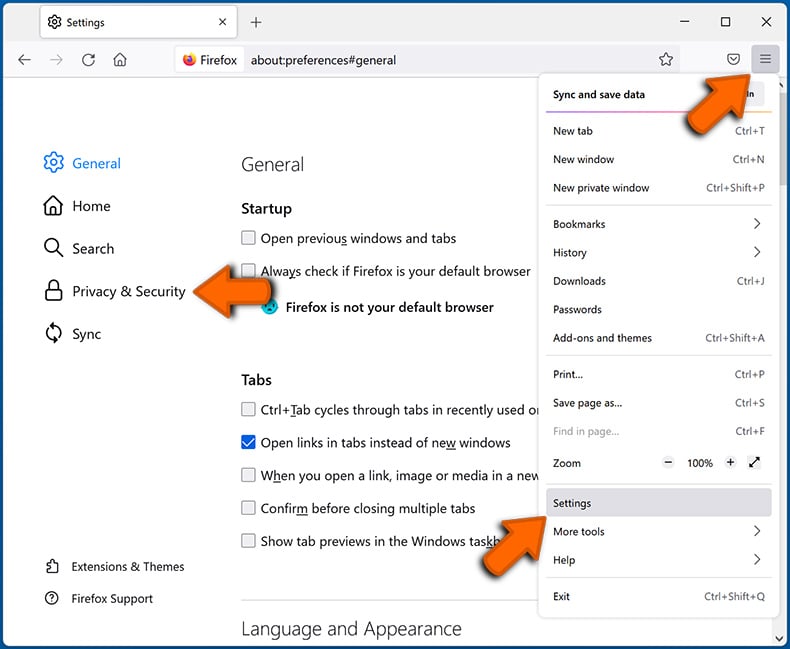
In the opened window, locate all suspicious URLs and block them using the drop-down menu or either remove them by clicking "Remove Website" at the bottom of the window (if you click "Remove Website" and visit the malicious site once more, it will ask to enable notifications again).
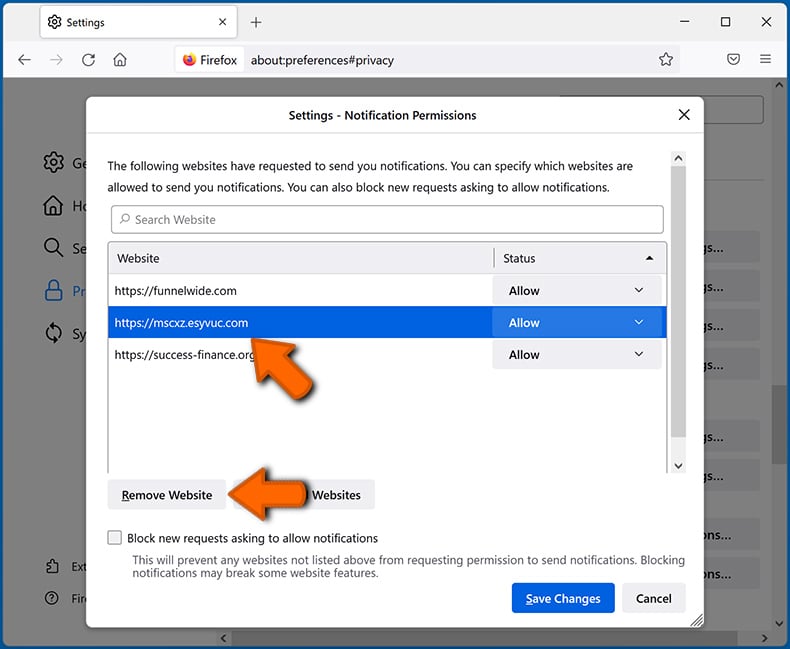
 Remove spam notifications from Microsoft Edge:
Remove spam notifications from Microsoft Edge:
Click the menu button (three dots) on the right upper corner of the Edge window and select "Settings". Click on "Cookies and site permissions" in the toolbar on the left hand side of the screen and select "Notifications".
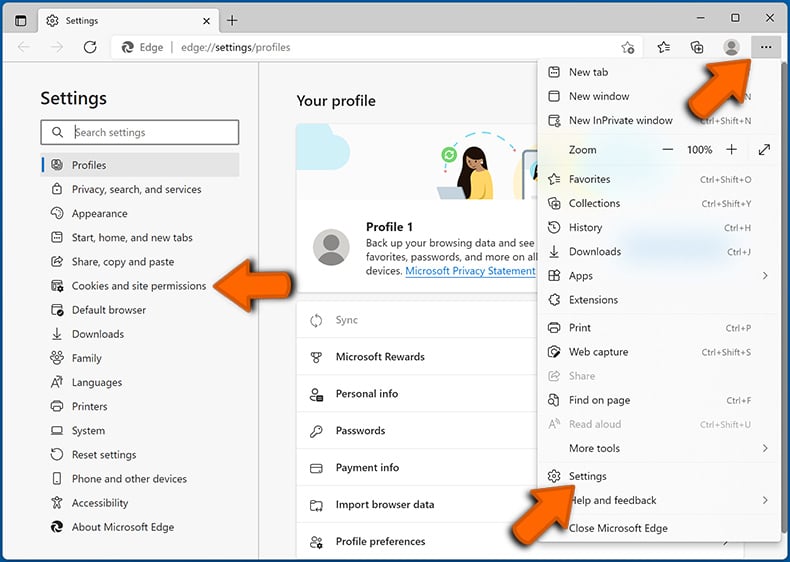
Click three dots on the right hand side of each suspicious URL under "Allow" section and click "Block" or "Remove" (if you click "Remove" and visit the malicious site once more, it will ask to enable notifications again).
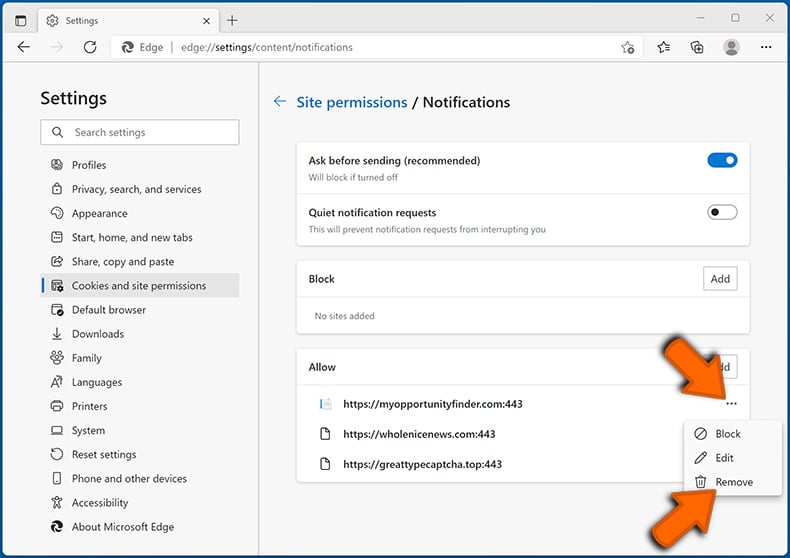
 Remove spam notifications from Safari (macOS):
Remove spam notifications from Safari (macOS):
Click "Safari" button on the left upper corner of the screen and select "Preferences...". Select the "Websites" tab and then select "Notifications" section on the left pane.
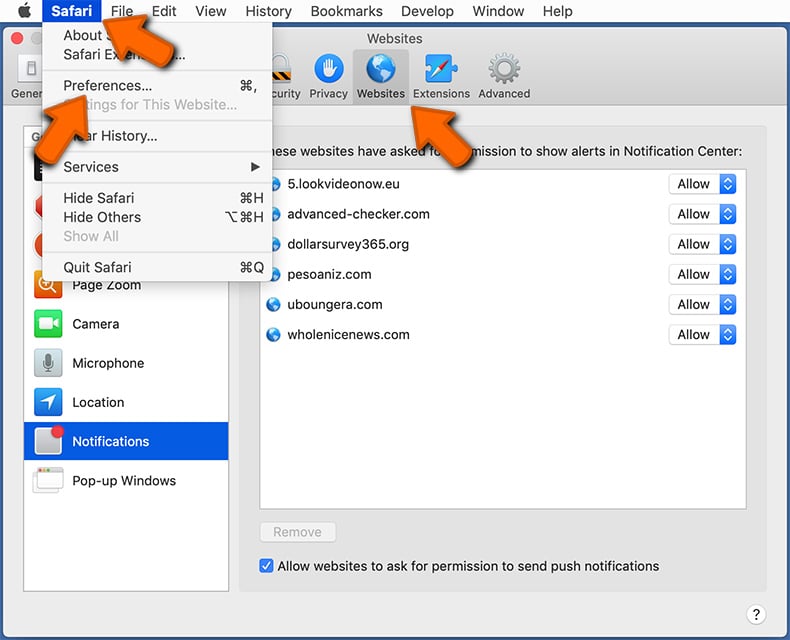
Check for suspicious URLs and apply the "Deny" option using the drop-down menu or either remove them by clicking "Remove" at the bottom of the window (if you click "Remove" and visit the malicious site once more, it will ask to enable notifications again)
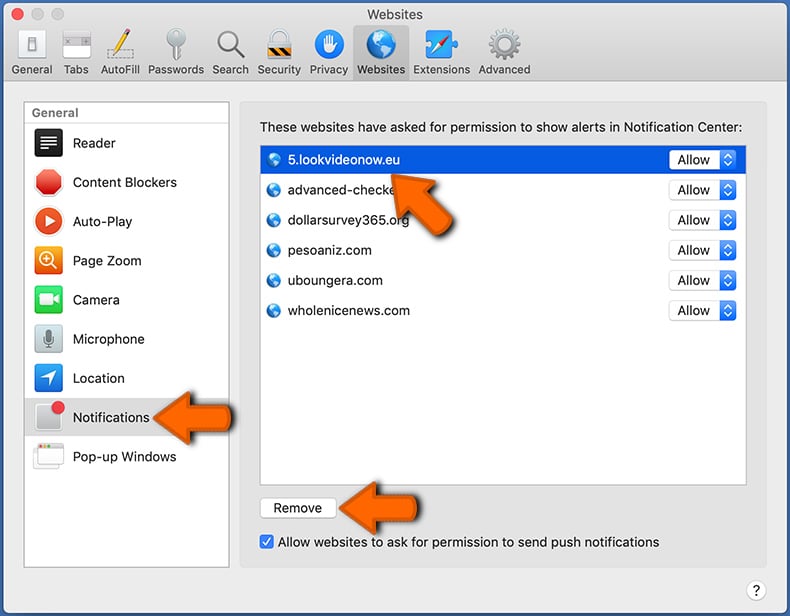
How to avoid browser notification spam?
Internet users should be very skeptical when being asked to allow notifications. While this is a useful feature that allows you to receive timely news from websites you like, deceptive marketers frequently abuse it.
Only allow notifications from websites that you fully trust. For added security - use an anti-malware application with a real-time web browsing monitor to block shady websites that tries to trick you into allowing spam notifications. We recommend using Combo Cleaner Antivirus for Windows.
Share:

Tomas Meskauskas
Expert security researcher, professional malware analyst
I am passionate about computer security and technology. I have an experience of over 10 years working in various companies related to computer technical issue solving and Internet security. I have been working as an author and editor for pcrisk.com since 2010. Follow me on Twitter and LinkedIn to stay informed about the latest online security threats.
PCrisk security portal is brought by a company RCS LT.
Joined forces of security researchers help educate computer users about the latest online security threats. More information about the company RCS LT.
Our malware removal guides are free. However, if you want to support us you can send us a donation.
DonatePCrisk security portal is brought by a company RCS LT.
Joined forces of security researchers help educate computer users about the latest online security threats. More information about the company RCS LT.
Our malware removal guides are free. However, if you want to support us you can send us a donation.
Donate
▼ Show Discussion